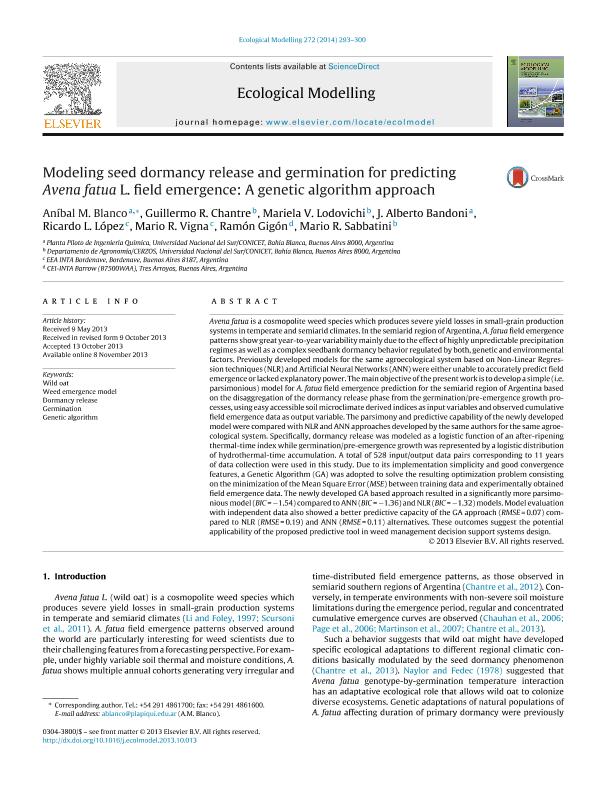Mostrar el registro sencillo del ítem
dc.contributor.author
Blanco, Anibal Manuel

dc.contributor.author
Chantre Balacca, Guillermo Ruben

dc.contributor.author
Lodovichi, Mariela Victoria

dc.contributor.author
Bandoni, Jose Alberto

dc.contributor.author
Lopez, Ricardo L.
dc.contributor.author
Vigna, Mario R.
dc.contributor.author
Gigón, Ramón
dc.contributor.author
Sabbatini, Mario Ricardo

dc.date.available
2017-01-16T20:22:56Z
dc.date.issued
2014-01
dc.identifier.citation
Blanco, Anibal Manuel; Chantre Balacca, Guillermo Ruben; Lodovichi, Mariela Victoria; Bandoni, Jose Alberto; Lopez, Ricardo L.; et al.; Modeling seed dormancy release and germination for predicting Avena fatua L. field emergence: A genetic algorithm approach; Elsevier Science; Ecological Modelling; 272; 1-2014; 293-300
dc.identifier.issn
0304-3800
dc.identifier.uri
http://hdl.handle.net/11336/11432
dc.description.abstract
Avena fatua is a cosmopolite weed species which produces severe yield losses in small-grain production systems in temperate and semiarid climates. In the semiarid region of Argentina, A. fatua field emergence patterns show great year-to-year variability mainly due to the effect of highly unpredictable precipitation regimes as well as a complex seedbank dormancy behavior regulated by both, genetic and environmental factors. Previously developed models for the same agroecological system based on Non-Linear Regression techniques (NLR) and Artificial Neural Networks (ANN) were either unable to accurately predict field emergence or lacked explanatory power. The main objective ofthe present work is to develop a simple (i.e. parsimonious) model for A. fatua field emergence prediction for the semiarid region of Argentina based on the disaggregation of the dormancy release phase from the germination/pre-emergence growth processes, using easy accessible soil microclimate derived indices as input variables and observed cumulative field emergence data as output variable. The parsimony and predictive capability of the newly developed model were compared with NLR and ANN approaches developed by the same authors for the same agroecological system. Specifically, dormancy release was modeled as a logistic function of an after-ripening thermal-time index while germination/pre-emergence growth was represented by a logistic distribution of hydrothermal-time accumulation. A total of 528 input/output data pairs corresponding to 11 years of data collection were used in this study. Due to its implementation simplicity and good convergence features, a Genetic Algorithm (GA) was adopted to solve the resulting optimization problem consisting on the minimization of the Mean Square Error (MSE) between training data and experimentally obtained field emergence data. The newly developed GA based approach resulted in a significantly more parsimonious model(BIC = −1.54) compared to ANN (BIC = −1.36) and NLR (BIC = −1.32) models. Model evaluation with independent data also showed a better predictive capacity of the GA approach (RMSE = 0.07) compared to NLR (RMSE = 0.19) and ANN (RMSE = 0.11) alternatives. These outcomes suggest the potential applicability of the proposed predictive tool in weed management decision support systems design.
dc.format
application/pdf
dc.language.iso
eng
dc.publisher
Elsevier Science

dc.rights
info:eu-repo/semantics/openAccess
dc.rights.uri
https://creativecommons.org/licenses/by-nc-nd/2.5/ar/
dc.subject
Wild Oat
dc.subject
Weed Emergence Model
dc.subject
Dormancy Release
dc.subject
Germination
dc.subject
Genetic Algorithm
dc.subject.classification
Otras Ingenierías y Tecnologías

dc.subject.classification
Otras Ingenierías y Tecnologías

dc.subject.classification
INGENIERÍAS Y TECNOLOGÍAS

dc.title
Modeling seed dormancy release and germination for predicting Avena fatua L. field emergence: A genetic algorithm approach
dc.type
info:eu-repo/semantics/article
dc.type
info:ar-repo/semantics/artículo
dc.type
info:eu-repo/semantics/publishedVersion
dc.date.updated
2017-01-13T19:51:32Z
dc.journal.volume
272
dc.journal.pagination
293-300
dc.journal.pais
Países Bajos

dc.journal.ciudad
Ámsterdam
dc.description.fil
Fil: Blanco, Anibal Manuel. Consejo Nacional de Investigaciones Cientificas y Tecnicas. Centro Cientifico Tecnol.conicet - Bahia Blanca. Planta Piloto de Ingenieria Quimica (i). Grupo Vinculado Al Plapiqui - Inv. y Desarrollo En Tecnologia Quimica; Argentina. Consejo Nacional de Investigaciones Científicas y Técnicas. Centro Científico Tecnológico Bahía Blanca. Planta Piloto de Ingeniería Química (i); Argentina
dc.description.fil
Fil: Chantre Balacca, Guillermo Ruben. Universidad Nacional del Sur. Departamento de Agronomía; Argentina. Consejo Nacional de Investigaciones Científicas y Técnicas. Centro Científico Tecnológico Bahía Blanca. Centro de Recursos Naturales Renovables de la Zona Semiárida(i); Argentina
dc.description.fil
Fil: Lodovichi, Mariela Victoria. Consejo Nacional de Investigaciones Científicas y Técnicas. Centro Científico Tecnológico Bahía Blanca. Centro de Recursos Naturales Renovables de la Zona Semiárida(i); Argentina. Universidad Nacional del Sur. Departamento de Agronomía; Argentina
dc.description.fil
Fil: Bandoni, Jose Alberto. Consejo Nacional de Investigaciones Científicas y Técnicas. Centro Científico Tecnológico Bahía Blanca. Planta Piloto de Ingeniería Química (i); Argentina. Universidad Nacional del Sur; Argentina
dc.description.fil
Fil: Lopez, Ricardo L.. Instituto Nacional de Tecnologia Agropecuaria. Centro Reg.buenos Aires. Estacion Exptal.agrop.bordenave; Argentina
dc.description.fil
Fil: Vigna, Mario R.. Instituto Nacional de Tecnologia Agropecuaria. Centro Reg.buenos Aires. Estacion Exptal.agrop.bordenave; Argentina
dc.description.fil
Fil: Gigón, Ramón . Instituto Nacional de Tecnología Agropecuaria. Chacra Experimental Integrada Barrow; Argentina
dc.description.fil
Fil: Sabbatini, Mario Ricardo. Consejo Nacional de Investigaciones Científicas y Técnicas. Centro Científico Tecnológico Bahía Blanca. Centro de Recursos Naturales Renovables de la Zona Semiárida(i); Argentina. Universidad Nacional del Sur. Departamento de Agronomía; Argentina
dc.journal.title
Ecological Modelling

dc.relation.alternativeid
info:eu-repo/semantics/altIdentifier/url/http://www.sciencedirect.com/science/article/pii/S0304380013004808
dc.relation.alternativeid
info:eu-repo/semantics/altIdentifier/doi/http://dx.doi.org/10.1016/j.ecolmodel.2013.10.013
Archivos asociados
